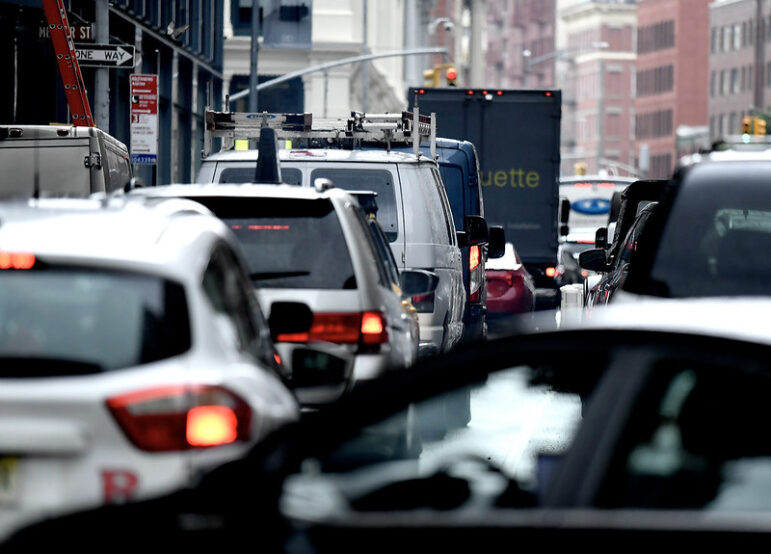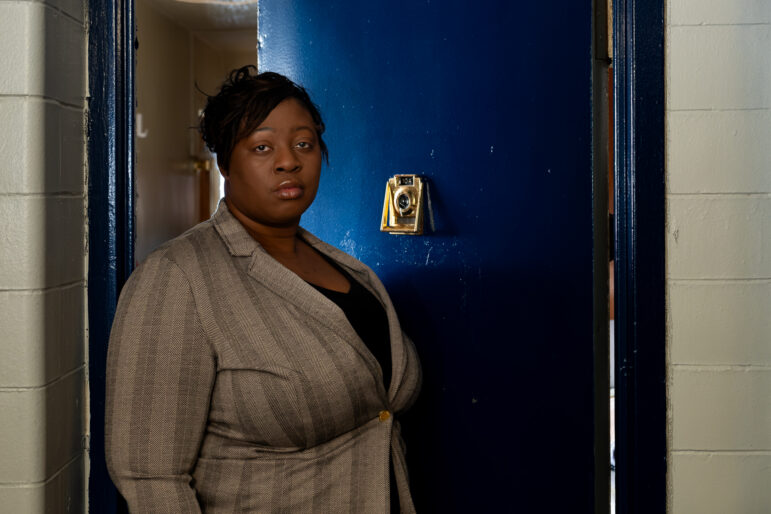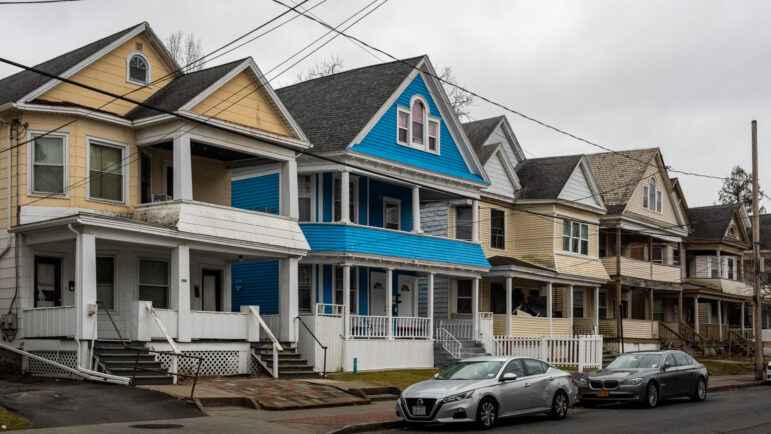
Rob Bennett/Mayoral Photography Office
The mayor and governor, seen at a 2014 press conference. Cuomo has faulted de Blasio for his handling of the homeless crisis, but the story behind the rising shelter numbers is not one of a botched policy.
After Bill de Blasio’s first year in office, City Limits took a look at the state of the city’s homelessness epidemic. Though de Blasio had been elected on promises to reverse the unabated rise in homelessness, by the end of his first year, the shelter count had shot up from 53,000 to 59,000 individuals. Many advocates, however, encouraged by a number of reforms set in motion by the mayor, appeared patient for the trend to reverse—even as some called for more and swifter action.
A look at year two is not so rosy as the administration would like, though not as incriminating as critics would have it. Homelessness declined to about 55,700 by July 2015, falsely raising hopes of a successful turnaround, then rose again to over 58,400 by January 2016. As of Monday, it had dipped down to 57,830. Some argue that the rate is steadying, though not everyone is so hopeful.
Break this down further, and you’ll find different trends for different categories of people. The shelter count for single adults and adult families (usually couples, or cohabitating adult relatives without minors) has continued to rise steadily since de Blasio took office, while the rate for homeless families with children has plateaued.
According to Giselle Routhier, policy director at Coalition for the Homeless, the administration’s policy of giving shelter residents priority for public housing has made a difference for homeless families with children. A greater share of homeless single adults and adult families, however, face mental health challenges and will stand to benefit when the administration follows through with its plan to build supportive housing.
Prevention efforts don’t buck the trend
De Blasio can’t be blamed for lack of effort. On taking office, his administration and the state pushed for a 50 percent increase in funding for HomeBase, the city’s homelessness prevention program, increasing the number of monthly enrollments by roughly 1,000. Thanks in part to the city’s expansion of free legal services and a rent freeze for rent stabilized tenants, evictions are down from 28,849 in 2013 to 21,988 in 2015. Yet despite these efforts, the number of homeless single and adult families entering shelter each month continues to rise.
Routhier says the trend in part reflects a good thing: The administration has reformed a draconian eligibility process, allowing more families with children and adult families to obtain shelter. During the Bloomberg administration, the share of applying families deemed eligible for shelter decreased from 40 percent to 36 percent, with possibly more families told to double up. De Blasio brought the rate up to 50 percent for single adults and 60 percent for families during his first year, though this winter rates fell back to Bloomberg-era levels.
Yet changed eligibility rules does not explain the increase of enrollments at single adult shelters, where there is no eligibility screening process.
The administration says rising numbers reflect its success bringing individuals who live on the street indoors to shelter. The total number of chronically homeless individuals placed into housing or shelter increased from below 600 in 2014 to about 1,100 in 2015—a significant increase, but still not enough to explain the entire 2,700 increase in the shelter population this fall.
A report by the Manhattan Institute, a conservative think tank, suggests that the renewed provision of housing assistance for the homeless—from rent vouchers to the policy giving homeless families a priority for NYCHA units—may induce more people to enter shelter. The Coalition for the Homeless says this is a myth refuted by academic research and the city’s own experience: Bloomberg’s elimination of housing assistance caused homelessness to skyrocket, not decline.
Rather, as some advocates and shelter providers argue, it is simply too soon to expect the administration’s prevention efforts to have made a large impact, while the roots of the homelessness crisis—the lack of affordable housing—only worsens. Since de Blasio took office, the average rent for a one bedroom apartment has increased from $2,716 to $3,152.
Still, Arnold Cohen, President and CEO of Partnership for the Homeless, thinks the city’s homeless prevention efforts could be better. Though the Department of Homeless Services describes HomeBase as a program that offers participants “an extensive network of neighborhood-based services” including rent aid and job placement assistance, Cohen says the program is actually focused on offering short-term aid to divert people from the shelter system.
“[HomeBase was] never designed to create the kind of community support systems that really will address the underlying causes of homelessness,” Cohen says. A better program, he says, would provide long-term support to families and link them with a host of community resources to address issues ranging from economic instability to mental health and housing quality to childcare.
New solutions don’t mean faster exits
The shelter tally isn’t just about who is coming in; it also reflects who is or isn’t moving out. And moving the homeless to permanent housing has been a much greater problem than the administration expected. Shelter exit rates per month are not that much higher than before de Blasio took office for single adults and adult families. In fact, this fiscal year, the average length of stay in a shelter for single adults and adult families is 19 and 25 days longer, respectively, than during the previous fiscal year. Exit rates for families look better, and they are staying in shelters for about the same length of time as last year.
De Blasio’s restoration of a policy giving homeless people priority to vacant NYCHA units and Section 8 vouchers helped families the most. NYCHA units tend to be family-sized, with few studio units, and NYCHA usually prioritizes families with children for Section 8 vouchers, according to Routhier. In 2014, the administration moved homeless families into 750 vacant public housing units and 280 Section 8 apartments—a step toward progress, advocates said, but falling short of their calls to prioritize the homeless for 2,500 NYCHA units and a third of available federal Section 8 vouchers. In 2015, the administration boosted that number to 1,250 public housing units, in addition to 500 Section 8 subsidized vouchers.
Another initiative, the city’s new Living In Communities rental assistance program (LINC), stood to benefit both families and single individuals but has faced stumbling blocks. Last November, the city revealed that only 20 percent of LINC vouchers had been used. Part of the challenge has been getting landlords to accept the new vouchers: thanks to Bloomberg’s discontinuation of the Advantage voucher program in 2011, many landlords, fearing LINC will also vanish, illegally turn away voucher users.
In light of these difficulties, the de Blasio administration is once again boosting its efforts to address the crisis. The proposed FY 2017 budget includes increasing HomeBase’s budget from this year’s $2.4 million to $4 million, and sets aside $9 million for caseworkers to help shelter residents move to NYCHA housing. The mayor is also investing $16.9 million in adult shelter programming and $12.5 million to operate the first of 15,000 new units of supportive housing. A report on the administration’s 90-day review of the Department of Homeless Services, which ended March 14, is forthcoming.
Advocates, meanwhile, are calling for greater focus on the provision of supportive and below-market permanent housing, including a greater designation of NYCHA and HPD-subsidized housing units for the homeless. While de Blasio’s Housing New York plan calls for the creation of permanent housing for the homeless beyond his 15,000 units of supportive housing, the mayor has not specified what percent of the plan’s 80,000 new affordable units will be allotted for the homeless. The Coalition for the Homeless is calling for at least 10 percent.
Furthermore, the Coalition is calling on Cuomo to step up his game: While the governor has said he will pay for 20,000 new units of supportive housing over the next 15 years, he has so far budgeted for only 6,000.
Cohen demands a complete overhaul of the administration’s strategy, one that focuses far less on providing temporary vouchers and shelter services.
“The lens through which they’re viewing the problem is: ‘we have an emergency and what the heck are we going to do?'” says Cohen. “I’m not hearing the long-term planning. It feels as if we’re opening more shelters, we’re going to employ more outreach teams…We just need a whole new paradigm.”









One thought on “What’s Behind the Rise in City Homeless Shelter Numbers?”
THERE IS A REAL LACK OF HOUSING FOR POOR SINGLE ADULTS OF BOTH GENDERS OF BOTH YOUNG AND OLD;WE ARE DISCRIMINATED AGAINST AS A CLASS;SINGLE ADULTS PAY A DISPROPPORTIONATE AMOUNT OF THEIR INCOME ON RENT;WHAT MS LEW ALSO NEEDS TO UNDERSTAND IS THAT MANY SINGLE PEOPLE COME TO NEW YORK BECAUSE OF THEIR LIFESTYLES;IN PARTICULAR MEN AND WOMEN WHO ARE GAY OR TRANSGENDER AS WELL SINGLE PEOPLE WITHOUT FAMILIES WHO COME TO NEW YORK AND OTHER LARGE CITIES TO FIND KINDRED SOULS.